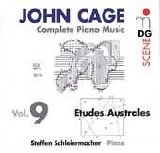If the Sonatas and Interludes for Prepared Piano are John Cage’s Chopin A-flat Polonaise, his Etudes Australes are Beethoven’s Hammerklavier, Liszt’s Transcendental Etudes, and Boulez’s Second Sonata rolled into one. I speak figuratively, of course, but you get my drift. As is often the case with large-scale works dating from Cage’s later years, an elaborate pre-compositional agenda governs the outcome. Cage plotted these four books of eight etudes apiece around star maps of the Southern Hemisphere. He placed transparencies on top of the maps and essentially transcribed them into music notation while deriving certain performance elements such as duration, density, or frequency of chord repetitions from his trusty I Ching. The music is spread onto four staves on the page like a piano duet. The top two staves are the right hand’s exclusive turf, and the bottom staves belong to the left hand only. Neither hand may help out the other, not even if the notation on two staves scurries up and down the keyboard or indicates thick aggregates of chords that move in rapid succession.
While Cage indicates neither specific tempos nor dynamic markings, his stemless noteheads are laid out in precise proportion to each other. The piano may be unprepared, but hopefully not the pianist, who requires an immense amount of physical preparation and mental forethought to convey each etude’s sonorous potential. Steffen Schleiermacher discovers uncharted layers of harmonic density by way of his varied articulations and inner dynamics, which contrast to the relatively neutral tonal palette of the work’s dedicatee, Grete Sultan. Claudio Crismani’s performances on the RS label, however, create a more incisive impression by virtue of closer miking and, in most cases, quicker basic tempos (his total timing adds up to less than two hours, while Schleiermacher clocks in at almost three hours and 22 minutes!). The verdict? A toss-up, although Crismani’s well-meaning but poorly written booklet notes don’t come close to the intelligent and insightful annotations Schleiermacher provides.
































